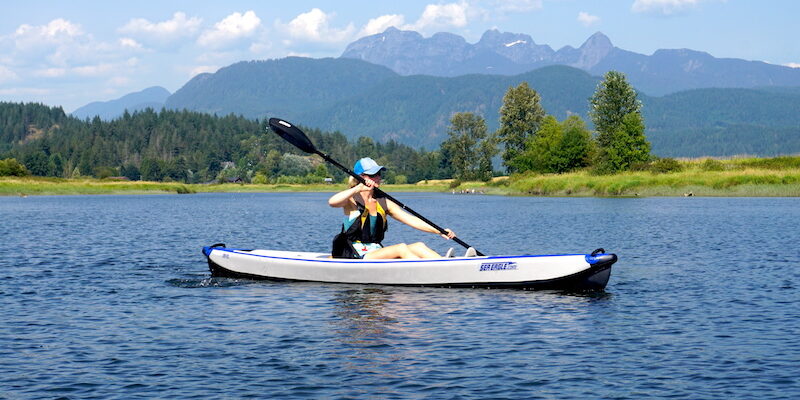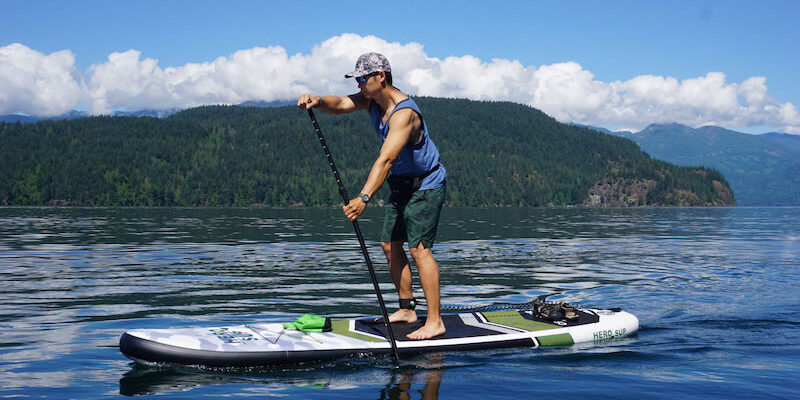It is important to understand how to properly attach and use a removable skeg on an inflatable kayak so that you get the best performance possible.
Sometimes if the kayak only has a small skeg it will be permanently attached.
However other models have a large removable skeg that provides for good tracking and speed.
There are two things that are important in order for your skeg to work properly:
- The skeg needs to be securely locked into the fittings before you inflate the kayak.
- The floor of the kayak needs to be inflated as solid as possible which helps with the strength of the skeg and the tracking.
If you have done both of these things properly the skeg is completely secure.
With any kayak that has an obstruction sticking out from the bottom such as a skeg it is important to take care not to hit anything that could bend or break it.
This would be the same for a kayak that has a rudder, for a boat that has a motor, etc.
No matter what kayak I am paddling, whether it is an inflatable or a hard shell, I always take care of the back end steering or tracking device (skeg, rudder, or directional stabilizer) as these are important to the performance of the kayak.
I am careful not to paddle in extremely shallow water so as not to do damage to them and if I need to bring my kayak up on shore I usually get out before the back end hits the bottom rocks and lift the back end up.
Although dragging the kayak to shore is NOT a problem as most inflatable kayaks are designed to be able to handle that.
How to Protect your Skeg
I was taught in kayaking lessons long ago that you always protect the steering device.
I was taught that if kayaking with a rudder it is important to lift the rudder out of the water when kayaking in rocky areas or when dragging the kayak up to shore.
Unfortunately with a skeg we do not have the option of “lifting it up” so it is up to us to avoid the obstructions.
If you are paddling with a skeg on any type of kayak it will always be important to avoid rocks and branches.
If you will mostly be kayaking in areas where it is unavoidable to hit rocks, etc. then either you should remove your skeg for that type of paddling or perhaps a different kayak might be in order.
Whitewater with a Skeg?
If your inflatable kayak is designed to be rugged enough to handle whitewater rapids then it is important to understand that you must remove your skeg before whitewater paddling.
No one who does whitewater kayaking wants a skeg because of course it would get in the way.
The main focus in whitewater kayaking is maneuverability and control, not tracking and speed and a skeg is never used.
While in whitewater the trick to keeping the kayak in the right place is in the technique of the stroke.
If your inflatable kayak has a removable skeg that means that it can be used for flatwater paddling (with the skeg) or for whitewater (without the skeg).
However if you are seriously considering only doing whitewater paddling there are certain models that are designed specifically for this.
Kayaking without the Skeg
Normally if kayaking in open water such as in lakes or in the ocean you will always want to use your skeg as it will provide the tracking needed for good performance.
Without the skeg you will not get the same tracking nor will you be able to get the good speeds.
If you will be paddling in water where rocks and downed trees are an issue then I would suggest not using the skeg if you have the option to remove it.
You will not have the same speed or good tracking without the fin attached but it will be great for river kayaking because there is nothing sticking out from the bottom of the kayak to hit debris or get stuck.
In Conclusion
The point is that an inflatable kayak that has a good size skeg can be fantastic to paddle as it has the possibility of offering great tracking and speed.
Most skegs are built to be very sturdy and to withstand a fair amount of abuse.
However nothing is indestructible so it is up to you to attach the skeg properly and care for it as best you can in order to preserve the high performance of the kayak.
One of my favourite inflatable kayaks that has a removable fin is the Sea Eagle 380X. It’s a very versatile kayak that can be used in most types of water.


Hi~ I’ve just bought an Intex K1 challenger, is it useful to add two more skeg like the ones on the Decatholon inflatable kayaks to improve speed? Im thinking about adding two small ones at the front.
Thanks~
Hey Jackson, I haven’t tried it but it’s an interesting thought. If you give it a go, I’d love to hear how it works out!
Just bought an inflatable kayak. New to the whole thing. I took it out in a calm river and it seamed like I was fighting to keep it straight. Now I know that the skeg that came with it helps. My question is, if I put another skeg in the front and have two will that help even more to keep it straight. I just wants to be on the water and not have to work to hard to go anywhere and stay in a straight line. No white water or anything just a calm river 🙂. Thanks
You’d be better off adding more fins to the back end as opposed to the front. If your kayak only came with one large fin then you could add two smaller side fins to the back end. Or possibly upgrade to a better fin on the back depending on what came wth your kayak.
Does anyone know where I can buy a Sevylor skeg for the Tahiti ?
I don’t know unfortunately. I did a quick search but came up empty. Good luck, I hope you’re able to find it!
I built mine: https://rick.sparber.org/AllPlasticSkeg.pdf
This is very cool!! Thank you so much for sharing Rick!
I checked with the UK distributor for Sevylor and the same skeg fits the Tahiti, Tahoma and the Riviera models, so I just bought one from an outdoor store on eBay.
I have a Seaeagle Paddleski that I can rig for paddling, fishing or sailing. When rigged for sailing, a frame work has to be installed for the leeboards which can be a pain if you want to fish in the morning and sail in the afternoon. My question is, can I install 2 removable skegs, one for each tube, and use them in place of the leeboards?
Technically it should work. You could easily glue on a couple of fin boxes. However it’s not something I’ve ever heard of anyone doing before so I can’t say for sure. I would check with Sea Eagle directly and get their advice before trying it.
I have a sevylor bali kayak and I need to know how to properly place the skeg. Can you help?
how do you remove the skeg in a K1
The skeg in my inflatable kayak is stuck, probably because of being dragged in sand. Any suggestions for getting it off ?
Hey Chris, I’ve had that happen several times. I can usually give it a really big yank and jam it out of there. You’re right it’s most likely from sand. You can try running a hose on it but if it absolutely won’t come out leave it on for a bit, it will likely loosen up over time.
I am pushing down on this two areas and pushing skeg toward bow it won’t slide out. Is that all you do?
Hello. I just bought a challenger k1 and I’ll need to use a kayak ramp in my area. Do I have to use the skeg? That might be a problem.
Thanks
Brenda 🙂
Hi Brenda, You can definitely use the Challenger K1 without the skeg. It won’t track as well but it’s doable. It will just take a little more effort to keep it on a straight course. 🙂
October 8th, 2014
I found the skeg article interesting.
I bought an old Stearns Cordova.
It had no skeg, so I made a prototype that secures to the rear carrying strap and found it rear-ly effective 🙂
I paddle in river, sea and salt-marsh, and the skeg hinges up safely when it hits bottom (except in reverse!).
How do I upload a photo?
Anyway, I wondered about making a bow-skeg, too, a bit like a Baidarka.
I’d like to know if anyone has tried this, has any thoughts or advice.
NRS has a skeg system consisting of various sized fins that can be changed out for varying conditions while enroute.This will necessitate coming ashore to change fin blades but works quite well.